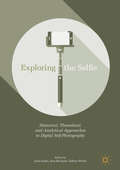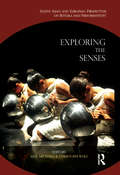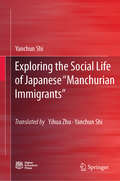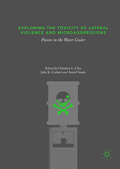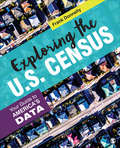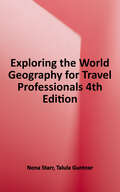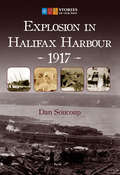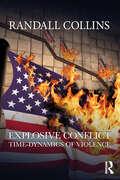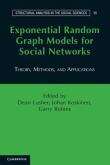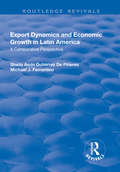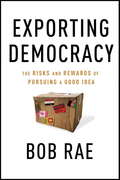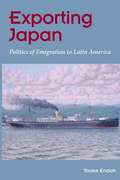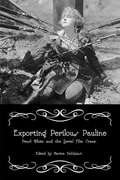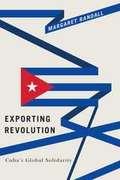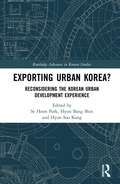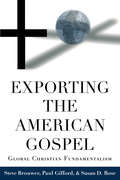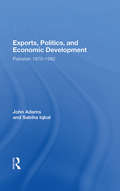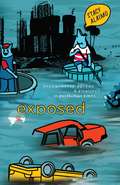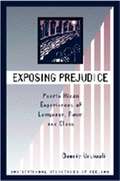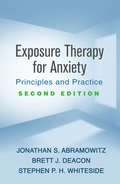- Table View
- List View
Exploring the Selfie: Historical, Theoretical And Analytical Approaches To Digital Self-photography
by Julia Eckel Jens Ruchatz Sabine WirthThis volume explores the selfie not only as a specific photographic practice that is deeply rooted in digital culture, but also how it is understood in relation to other media of self-portrayal. Unlike the public debate about the dangers of 'selfie-narcissism', this anthology discusses what the practice of taking and sharing selfies can tell us about media culture today: can the selfie be critiqued as an image or rather as a social practice? What are the technological conditions of this form of vernacular photography? By gathering articles from the fields of media studies; art history; cultural studies; visual studies; philosophy; sociology and ethnography, this book provides a media archaeological perspective that highlights the relevance of the selfie as a stereotypical as well as creative practice of dealing with ourselves in relation to technology.
Exploring the Senses: South Asian and European Perspectives on Rituals and Performativity
by Christoph Wulf Axel MichaelsThis fascinating volume offers a transdisciplinary and transcultural approach to understanding the senses by exploring themes in anthropologies of sound, sight, smell, taste, touch, and movement as expressed through aesthetic, perceptual, religious, and spiritual experiences. In drawing upon comparative perspectives from Indian and Western theories, the essays demonstrate the integral relation of senses with each other as well as with allied notions of the body, emotion and cultural memory. Stressing the continued relevance of senses as they manifest in a globalized world under the influence of new media, this work will interest scholars of anthropology, cultural studies, sociology, ritual studies, psychology, religion, philosophy, and history.
Exploring the Social Life of Japanese “Manchurian Immigrants”
by Yanchun ShiThe book studies the “Manchurian immigrants” from many important aspects suchas agricultural operation, education, religion, and women’s issues. It contains thefollowing features: first, readers can get deeper understanding on the “Manchurianimmigrants” policies by investigating the agriculture-based social life of the“Manchurian immigrants” in Northeast China; second, studying the life conditions ofthe “Manchurian immigrants” can make up for the lack of researches in related fieldto some extent; third, readers are given chances by this book to learn Japanese societyand Japanese people from another facet.
Exploring the Toxicity of Lateral Violence and Microaggressions: Poison In The Water Cooler
by Christine L. Cho Julie K. Corkett Astrid SteeleExamining the subtle forms of aggression, violence, and harassment that occur in our society and manifest in institutions and places of work, the expert contributors collected here describe the experience of social marginalization and expose how vulnerable individuals work to navigate exclusionary climates. This volume explores how bodies disrupt the status quo in multiple contexts and locations; provides insights into how institutions are structured and how practices that may cause harm are maintained; and, finally, considers progressive and proactive alternatives. This book will be a key resource for academics and professionals in education, sociology, nursing, law, business and political science, as well as organizations and policymakers grappling with aggression in the workplace.
Exploring the U.S. Census: Your Guide to America’s Data
by Francis P. DonnellyExploring the U.S. Census gives social science students and researchers alike the tools to understand, extract, process, and analyze data from the decennial census, the American Community Survey, and other data collected by the U.S. Census Bureau. Donnelly′s text provides a thorough background on the data collection methods, structures, and potential pitfalls of the census for unfamiliar researchers, collecting information previously available only in widely disparate sources into one handy guide. Hands-on, applied exercises at the end of the chapters help readers dive into the data. Along the way, the author shows how best to analyze census data with open-source software and tools. Readers can freely evaluate the data on their own computers, in keeping with the free and open data provided by the Census Bureau. By placing the census in the context of the open data movement, this text makes the history and practice of the census relevant so readers can understand what a crucial resource the census is for research and knowledge.
Exploring the U.S. Census: Your Guide to America’s Data
by Francis P. DonnellyExploring the U.S. Census gives social science students and researchers alike the tools to understand, extract, process, and analyze data from the decennial census, the American Community Survey, and other data collected by the U.S. Census Bureau. Donnelly′s text provides a thorough background on the data collection methods, structures, and potential pitfalls of the census for unfamiliar researchers, collecting information previously available only in widely disparate sources into one handy guide. Hands-on, applied exercises at the end of the chapters help readers dive into the data. Along the way, the author shows how best to analyze census data with open-source software and tools. Readers can freely evaluate the data on their own computers, in keeping with the free and open data provided by the Census Bureau. By placing the census in the context of the open data movement, this text makes the history and practice of the census relevant so readers can understand what a crucial resource the census is for research and knowledge.
Exploring the World: Geography for Travel Professionals
by Nona Starr Talula GuntnerExploring the World opens the world to you like no other geography course you have experienced. While the “science” of geography is unavoidable, you will see the world as travel folks see it … as a kaleidoscope of places, people, and experiences just waiting to be sampled.
Explosion in Halifax Harbour, 1917 (Stories of Our Past)
by Dan SoucoupA riveting account of the collision of two ships—and the worst human-caused explosion in history before Hiroshima—with dozens of photos and illustrations. In late 1917, one of the greatest natural harbors in the world was humming with excitement. Halifax Harbor was filled with naval convoys and merchant vessels while factories worked overtime in support of the Allied war effort in Europe. But on December 6, Canada&’s worst disaster struck, as two ships—one carrying high explosives—collided. The resulting blast killed and injured thousands, razing the city&’s North End and destroying nearly everything in its path. This history is an account of tremendous human suffering and devastation, yet also of human bravery and survival against all odds. Chaos and confusion reigned that day in Halifax and Dartmouth, Nova Scotia, but what followed was a massive relief effort involving charitable assistance from all over the globe—especially Massachusetts. Explosion in Halifax Harbour, 1917 includes a detailed account of the event, chronicling many remarkable human tragedies, rescue and relief efforts, attempts to place blame for the collision, and the reconstruction program that created Canada&’s first government-assisted housing program. Also included are 60 full-color images as well as sidebars on many monuments and commemorations that pay tribute to this catastrophic event. &“Begins with a history of Halifax and its harbor and how important it was for the war effort in Europe…while there were countless acts of heroism, Soucoup writes there were also acts of looting and profiteering.&” —The Star
Explosive Conflict: Time-Dynamics of Violence
by Randall CollinsThis sequel to Randall Collins' world-influential micro-sociology of violence introduces the question of time-dynamics: what determines how long conflict lasts and how much damage it does. Inequality and hostility are not enough to explain when and where violence breaks out. Time-dynamics are the time-bubbles when people are most nationalistic; the hours after a protest starts when violence is most likely to happen. Ranging from the three months of nationalism and hysteria after 9/11 to the assault on the Capitol in 2021, Randall Collins shows what makes some protests more violent than others and why some revolutions are swift and non-violent tipping-points while others devolve into lengthy civil wars. Winning or losing are emotional processes, continuing in the era of computerized war, while high-tech spawns terrorist tactics of hiding in the civilian population and using cheap features of the Internet as substitutes for military organization. Nevertheless, Explosive Conflict offers some optimistic discoveries on clues to mass rampages and heading off police atrocities, with practical lessons from time-dynamics of violence.
Explosivity: Following What Remains
by Javier Arbona-HomarHow explosions across history reveal the violence embedded in San Francisco&’s landscape Offering a novel approach to contemporary landscape studies, Explosivity unearths the hidden legacies of violence that have shaped the physical and cultural environment of the San Francisco Bay area. As he sifts through the historical debris of previous centuries, Javier Arbona-Homar analyzes a series of explosions that took place between 1866 and 2011 to call attention to the scattered remnants of militarism and racialized capitalism embedded in the region&’s geography. From incidents involving nineteenth-century explosives manufacturing and World War II munitions loading to radical activism and contemporary television productions, Arbona-Homar locates a pattern of historical violence that refocuses the broader racial and colonial context. Citing the material, social, and political conditions that gave rise to these disparate episodes, he reviews the historic erasure of those driving forces and puts forth alternative possibilities for how such disasters might be memorialized. Synthesizing a diverse set of field research methods, including oral histories and site visits, and supplemented by specially commissioned landscape photographs by Andrea Gaffney, Explosivity presents a radical exercise in the exposition of public memory. Retail e-book files for this title are screen-reader friendly with images accompanied by short alt text and/or extended descriptions.
Expo 67
by Johanne Sloan Rhona Richman KenneallyExpo 67, the world's fair held in Montreal during the summer of 1967, brought architecture, art, design, and technology together into a glittering modern package. Heralding the ideal city of the future to its visitors, the Expo site was perceived by critics as a laboratory for urban and architectural design as well as for cultural exchange, intended to enhance global understanding and international cooperation. This collection of essays brings new critical perspectives to Expo 67, an event that left behind a significant material and imaginative legacy.The contributors to this volume reflect a variety of interdisciplinary approaches and address Expo 67 across a broad spectrum ranging from architecture and film to more ephemeral markers such as postcards, menus, pavilion displays, or the uniforms of the hostesses employed on the site. Collectively, the essays explore issues of nationalism, the interplay of tradition and modernity, twentieth-century discourse about urban experience, and the enduring impact of Expo 67's technological experimentation. Expo 67: Not Just a Souvenir is a compelling examination of a world's fair that had a profound impact locally, nationally, and internationally.
Exponential Random Graph Models for Social Networks
by Dean Lusher Johan Koskinen Garry RobinsExponential random graph models (ERGMs) are increasingly applied to observed network data and are central to understanding social structure and network processes. The chapters in this edited volume provide a self-contained, exhaustive account of the theoretical and methodological underpinnings of ERGMs, including models for univariate, multivariate, bipartite, longitudinal and social-influence type ERGMs. Each method is applied in individual case studies illustrating how social science theories may be examined empirically using ERGMs. The authors supply the reader with sufficient detail to specify ERGMs, fit them to data with any of the available software packages and interpret the results.
Export Dynamics and Economic Growth in Latin America: A Comparative Perspective
by Sheila A Gutierrez de Pineres Michael J FerrantinoThis title was first published in 2000: This text aims to be essential reading for anyone who wishes to understand the microeconomic foundations behind the Latin American export boom, the ways in which government policies affecting exports may retard or promote economic growth, and the future prospects of the proposed Free Trade Association of the Americas. The authors conduct an econometric analysis which uses measures of export diversification, structural change in exports, and exports similarity which provide a basis for region-wide comparisons. The cases of Chile, Colombia, Mexico and Venezuela are analyzed in particular detail. Cross-country analysis focuses on the potential role of export diversification in promoting economic growth, in the context of other important determinants of growth.
Exporting Democracy
by Bob RaeThe way most Western politicians talk, democracy is the pinnacle of civilization, the best political system there is. Many think it's the system the rest of the world ought to adopt. Bob Rae is not one of them. He is too well informed about the difficulties and dangers of implanting democracy in foreign lands. Exporting Democracy is an eloquently argued book in which Rae brings his lively, nuanced understanding to bear on the history and current fortunes of this powerful idea. He shows how it and the related ideas of freedom, human rights, and federalism have been pushed to centre stage by the collapse of Soviet communism and by ongoing wars to topple secular and religious dictatorships in the Middle East. He's also witnessed attempts to implant democracy in three countries riven by tribal and ethnic divisions, Iraq, Afghanistan, and Sri Lanka, and offers readers a cool appraisal of the effort.From the Hardcover edition.
Exporting Japan: Politics of Emigration to Latin America
by Toake EndohExporting Japan examines the domestic origins of the Japanese government's policies to promote the emigration of approximately three hundred thousand native Japanese citizens to Latin America between the 1890s and the 1960s. This imperialist policy, spanning two world wars and encompassing both the pre-World War II authoritarian government and the postwar conservative regime, reveals strategic efforts by the Japanese state to control its populace while building an expansive nation beyond its territorial borders. Toake Endoh compellingly argues that Japan's emigration policy embodied the state's anxieties over domestic political stability and its intention to remove marginalized and radicalized social groups by relocating them abroad. Documenting the disproportionate focus of the southwest region of Japan as a source of emigrants, Endoh considers the state's motivations in formulating emigration policies that selected certain elements of the Japanese population for "export." She also recounts the situations migrants encountered once they reached Latin America, where they were often met with distrust and violence in the "yellow scare" of the pre-World War II period.
Exporting Perilous Pauline: Pearl White and Serial Film Craze
by Marina DahlquistExceptionally popular during their time, the spectacular American action film serials of the 1910s featured exciting stunts, film tricks, and effects set against the background of modern technology, often starring resourceful female heroines who displayed traditionally male qualities such as endurance, strength, and authority. The most renowned of these "serial queens" was Pearl White, whose career as the adventurous character Pauline developed during a transitional phase in the medium's evolving production strategies, distribution and advertising patterns, and fan culture. In this volume, an international group of scholars explores how American serials starring Pearl White and other female stars impacted the emerging cinemas in the United States and abroad. Contributors investigate the serial genre and its narrative patterns, marketing, and cultural reception, and historiographic importance, with essays on Pearl White's life on and off the screen as well as the "serial queen" genre in Western and Eastern Europe, India, and China. Contributors are Weihong Bao, Rudmer Canjels, Marina Dahlquist, Monica Dall'Asta, Kevin B. Johnson, Christina Petersen, and Rosie Thomas.
Exporting Revolution: Cuba's Global Solidarity
by Margaret RandallIn her new book, Exporting Revolution, Margaret Randall explores the Cuban Revolution's impact on the outside world, tracing Cuba's international outreach in health care, disaster relief, education, literature, art, liberation struggles, and sports. Randall combines personal observations and interviews with literary analysis and examinations of political trends in order to understand what compels a small, poor, and underdeveloped country to offer its resources and expertise. Why has the Cuban health care system trained thousands of foreign doctors, offered free services, and responded to health crises around the globe? What drives Cuba's international adult literacy programs? Why has Cuban poetry had an outsized influence in the Spanish-speaking world? This multifaceted internationalism, Randall finds, is not only one of the Revolution's most central features; it helped define Cuban society long before the Revolution.
Exporting Urban Korea?: Reconsidering the Korean Urban Development Experience (Routledge Advances in Korean Studies)
by Se Hoon ParkA detailed examination of the “Korean development model” from its urban dimension, evaluating its sociopolitical contexts and implications for international development cooperation. There is an increasing tendency to use the development experience of Asian countries as a reference point for other countries in the Global South. Korea’s condensed urbanization and industrialization, accompanied by the expansion of new cities and industrial complexes across the country, have become one such model, even if the fruits of such development may not have been equitably shared across geographies and generations. The chapters in this book critically reassess the Korean urban development experience from regional policy to new town development, demonstrating how these policy experiences were deeply rooted in Korea’s socioeconomic environment and discussing what can be learned from them when applying them in other developmental contexts. This book will be of great interest to scholars and researchers in the field of urban studies and developmental studies in general, and in Korea’s (urban) development experience in particular.
Exporting the American Gospel: Global Christian Fundamentalism
by Susan D. Rose Paul Gifford Steve BrouwerAs the pressures of globalization are crushing local traditions, millions of uprooted people are buying into a new American salvation product. This fundamentalist Christianity, a fusion of American popular religion and politics, is one of the most significant cultural influences exported from the United States. With illuminating case studies based on extensive field research, Exporting the American Gospel demonstrates how Christian fundamentalism has taken hold in many nations in Africa, Latin America and Asia.
Exports, Politics, And Economic Development: Pakistan, 1970-1982
by John Q AdamsDuring the 1970s, Pakistan's export policies went through two major transformations as a result of realignments among its internal interest groups, bringing about significant changes in export composition and performance. As leader of a coalition of labor, small business, and other mass interests, President Z. A. Bhutto supported a more equitable d
Exposed: Desire and Disobedience in the Digital Age
by Bernard E. HarcourtExploiting our boundless desire to access everything all the time, digital technology is breaking down whatever boundaries still exist between the state, the market, and the private realm. Bernard Harcourt offers a powerful critique of what he calls the expository society, revealing just how unfree we are becoming and how little we seem to care.
Exposed: Environmental Politics and Pleasures in Posthuman Times
by Stacy AlaimoOpening with the statement &“The anthropocene is no time to set things straight,&” Stacy Alaimo puts forth potent arguments for a material feminist posthumanism in the chapters that follow.From trans-species art and queer animals to naked protesting and scientific accounts of fishy humans, Exposed argues for feminist posthumanism immersed in strange agencies and scale-shifting ethics. Including such divergent topics as landscape art, ocean ecologies, and plastic activism, Alaimo explores our environmental predicaments to better understand feminist occupations of transcorporeal subjectivity.She puts scientists, activists, artists, writers, and theorists in conversation, revealing that the state of the planet in the twenty-first century has radically transformed ethics, politics, and what it means to be human. Ultimately, Exposed calls for an environmental stance in which, rather than operating from an externalized perspective, we think, feel, and act as the very stuff of the world.
Exposing Prejudice
by Bonnie UrciuoliPuerto Ricans in the United States face an array of language judgments. Their linguistic differences are culturally objectified as "accents," "mixed" or "broken language," and "bad" versus "good" English. These objectifications are about a lot more than language. They represent a complex and highly politicized mapping of racial exclusion and class location. Through ethnographic studies and interviews done on New York's Lower East Side and in the Bronx, the author examines in detail the intersection of race, class, and language in the working-class Puerto Rican experience.
Exposure Therapy for Anxiety
by Brett Deacon Jonathan AbramowitzGoing beyond one-size-fits-all approaches, this indispensable book describes how to design and implement exposure-based interventions for clients suffering from any type of pathological worry or fear. The expert authors translate cutting-edge theory and research into flexible guidelines for real-world clinical practice. They present the nuts and bolts of individualized assessment and treatment planning and offer strategies for engaging clients successfully. Chapters organized around common anxiety triggers feature a wealth of case examples and specific ideas for exposure exercises. Special topics include working with child clients and combining therapy with medication. Several reproducible handouts and forms are provided.
Exposure Therapy for Anxiety, Second Edition: Principles and Practice
by Jonathan S. Abramowitz Brett J. Deacon Stephen P. WhitesideNow revised and expanded to include cutting-edge acceptance-based techniques and a new focus on inhibitory learning, this is the leading guide to therapeutic exposure, a crucial element of evidence-based psychological treatments for anxiety. The book helps the clinician gain skills and confidence for implementing exposure successfully and tailoring interventions to each client's needs, regardless of diagnosis. The theoretical and empirical bases of exposure are reviewed and specialized assessment and treatment planning techniques described. User-friendly features include illustrative case examples, sample treatment plans, ideas for exercises targeting specific types of fears, and reproducible handouts and forms that can be downloaded and printed in a convenient 8½" x 11" size. New to This Edition *Chapter on acceptance and commitment therapy (ACT) techniques. *Reflects a shift in the field toward inhibitory learning--helping clients learn to tolerate anxiety and uncertainty to maximize long-term outcomes. *Chapter on uses of technology, such as computer-based therapy and virtual reality tools. *Conceptual, empirical, and clinical advances woven throughout.
